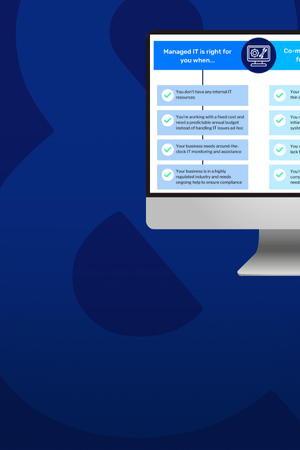By Chris Rossi | Director, Technology Advisory Services
With the ubiquity of cloud-based technologies and applications available today, imagining a world without the instant connectivity and flexibility they provide is difficult. Yet the pandemic has proven to be something of a stress test for businesses, highlighting those that could pivot quickly to remote and hybrid work because they had already enabled these systems. No matter where a business found itself on the technology spectrum—entirely in the cloud, balancing a hybrid of cloud and on-premises (“on-prem”) legacy systems, or operating exclusively outside of the cloud—the necessity of cloud-based solutions has driven a wave of change across industries. Not only are we rapidly moving into a space where all the technology used in our professional and personal lives is cloud-based, but the pace of that change has significantly accelerated in the past two years.
What is a Path to Cloud?
The cloud provides a remote ecosystem for software, storage, and applications accessed through a subscription. A business that relies on cloud-based technology doesn’t have to own and maintain its software, nor does it need to have the physical infrastructure on site to store and support it.
For the past decade, business technologies have steadily migrated to the cloud, forcing the obsolescence of legacy systems. Some businesses have kept pace, moving to full cloud solutions, while others have dragged their heels, either by not adopting any cloud-based technologies or straddling legacy and cloud systems. In the next five to 10 years all business applications will be true cloud solutions, making a transition to the cloud both timely and necessary.
A path to cloud provides the overarching strategic priority of moving a business to an entirely cloud-based solution for its technological needs. Though each business will have a different path depending on their starting point and priorities, some overarching themes of each path include:
- A marriage of technology and business strategies
- Focused priorities for every conversation about technology, infrastructure, modernization, changes, or adoption
- An ultimate goal of having all technologies—email, document servers, printing solutions, business applications, and more—on cloud applications
While achieving a total cloud environment is an accomplishment, bear in mind that the work is not over. Organizations should consistently evaluate their cloud-based tools to be sure their infrastructure is current, their security is tight, and they are aware of enhancements that could further support operational needs.
How Do We Establish the Right Cloud Transition Strategy for Our Organization?
To start mapping your path to cloud, you must first assess your current technology stack. Common questions to ask include:
- What are all the applications needed to run all our core business functions?
- What is already in the cloud, and what isn’t?
- What is the technology investment cycle for legacy systems?
- Where are the places where transition points naturally occur within the cycle?
- Are there other technology-related decision points to consider?
- How can the transition/decision points be leveraged to ensure steady progress on the path to cloud?
Fortunately, the transition to fully cloud-based operations does not have to be all or nothing and can be accomplished through interim steps along the way. For example, hosted-cloud solutions for servers provide businesses the opportunity to take a step towards meeting their goal of a true cloud solution.
No matter what, once the path to cloud priorities have been identified, leadership should specifically avoid investing in infrastructure that could stop their organization from reaching its destination.
Why is a Path to Cloud Strategy Important and Necessary?
Transitioning to cloud, whether gradual or immediate, provides strategic spending priorities that allow a business to move from on-prem to cloud at the right pace, without changing everything at once. It will enable executives and technology leaders to carefully evaluate how changing a single system can affect others that are in use and ensures that a total cloud environment is achieved by the business.
Challenges with Legacy Systems
Mapping and following a path to cloud saves your business time and money. Reliance on legacy applications leads to numerous issues that include:
- Tremendous fragmentation and skyrocketing costs
- Reliance on dwindling expertise as professionals with system knowledge retire or pivot
- The implementation of patchwork solutions to address new business needs that legacy software cannot support
- Time spent entering data into multiple systems that can’t talk to each other
Legacy technologies become challenging to work with as updates and improvements cease, meaning those systems can no longer meet business, customer, and vendor needs. As a result, the bottom line begins to suffer.
Benefits of Cloud Solutions
However, businesses that have invested in fully cloud-based systems not only avoid the problems above, but also reap benefits that include:
- Reduced need for physical space for technological equipment and servers
- An elimination of the labor and cost to maintain physical and legacy-based systems
- Consistent, yearly expenditures for technology solutions (rather than big budget upgrades that run in the hundreds of thousands every few years)
- Immediately available upgrades and updates that fully integrate into existing systems
Addressing Common Misconceptions About Cloud Migrations
The two most common misconceptions regarding the cloud are:
#1 The Cloud is Unreliable
The disruption of operations remains a lingering and important concern for some industries, particularly manufacturing. Fortunately, cloud-based technologies have an incredibly high success rate, making them more reliable than historically faulty local solutions. Most disruptions in cloud-based operations stem from legacy application incompatibility, failures in internet connectivity, and human error. To minimize their effects, businesses should move away from hybrid solutions that mix cloud-based and legacy applications, build redundancies into their internet connection, and utilize the checkpointing strategy—periodically saving their system state in an alternate location to ensure they can restore it in the event of a failure. Combining these strategies can help prevent disruptions and ensure a speedy restoration of operations in the rare instance that a failure occurs.
#2 Cybersecurity Risks Will Increase
Cloud-based systems carry significant cybersecurity advantages, often dwarfing what is possible on a local system because of the vast resources available. Organizations with legacy local area network environments utilize an outdated approach that essentially creates a single cybersecurity wall, making them much more vulnerable to security breaches. Once the wall is breached, attackers have the ability to access local servers and severely impact the business. True cloud environments, however, provide a sophisticated, protective system that safeguards information at multiple points. And, while many businesses assume a hybrid solution is an ideal balance between cloud-based solutions and familiar legacy technologies, the reality is that attempting to apply legacy security practices to cloud solutions leads to significant security risks. A fully cloud environment will provide the greatest security now and into the future.
Cloud-based technologies have existed for over a decade, yet early concerns still linger. Now that these technologies have matured, in some cases with hundreds of thousands of implementations, most reservations held by business leaders can be put to rest.
When you find yourself in a position to consider your options, it is crucial to work with experienced advisors who will take the time to understand your objectives and can seamlessly marry them with a cohesive, vendor-agnostic technology plan. Making technology decisions that run parallel to your business goals only benefits the product or service you provide.
Developing a Cloud Strategy that Leads to Business Success
Businesses across industries now face two options: follow a path to cloud or follow a path to obsolescence. Those that create clear and consistent priorities will make the transition smoothly, taking small steps along the way that ultimately lead them to a full cloud stack. Mapping your path to cloud presents an opportunity for your business to think bigger—to step back, examine your processes, tactics, and objectives, and determine how technology can be used to increase efficiency and optimize operations. While transitioning from idea to implementation can often represent the most daunting step in this process, you don’t have to go it alone.
Successfully overhauling—or even just tweaking—your technology strategy requires time, thoughtfulness, and experience. It also requires someone with an agnostic approach to specific vendors and service providers. SC&H’s Technology Advisory practice has the expertise and experience to help you on your path to cloud and to meet your business where it is today.
Tell us about your cloud technology needs.




